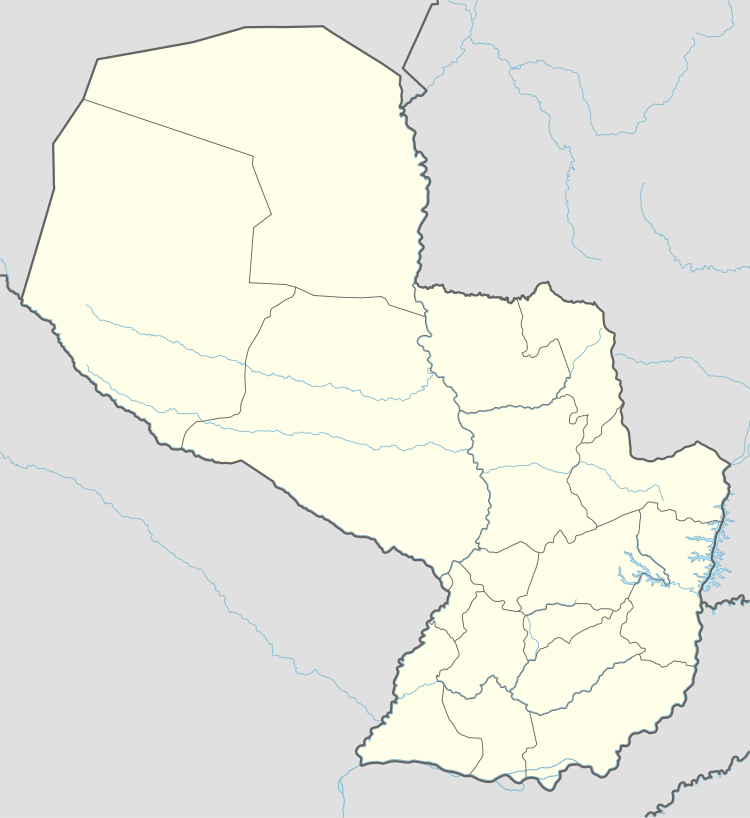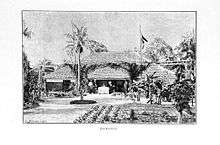Nueva Germania
Nueva Germania (New Germania) is a district of San Pedro Department in Paraguay. It was founded as a German settlement on 23 August 1887 by Bernhard Förster, a German nationalist, who was married to Elisabeth Förster-Nietzsche, sister of the German philosopher Friedrich Nietzsche. Förster's idea was to create a model community in the New World and to demonstrate the supremacy of German culture and society. Förster committed suicide after the settlement's initial failure.[1]
Nueva Germania | |
|---|---|
 Nueva Germania | |
| Coordinates: 23°54′0″S 56°42′12″W | |
| Country | |
| Department | San Pedro |
| Founded | 23 August 1887 by Bernhard Förster |
| Government | |
| • Intendente Municipal | Leonardo Saiz Arce |
| Area | |
| • Total | 20.008 km2 (7.725 sq mi) |
| Elevation | 132 m (433 ft) |
| Population (2008) | |
| • Total | 4,335 |
| • Density | 15.9/km2 (41/sq mi) |
| Time zone | -4 GMT |
| Postal code | 8470 |
| Area code(s) | (595) (44) |
It is located about 297 kilometres from Asunción, capital of the Republic of Paraguay.
History
Nueva Germania was founded in 1886 on the banks of the Aguaray-Guazú River, about 250 kilometres from Asunción by five, later fourteen, largely impoverished families from Saxony.[2] Led by Bernhard Förster and his wife, Elisabeth Förster-Nietzsche, the German colonists emigrated to the Paraguayan rainforest to put to practice utopian ideas about the superiority of the Aryan race. It was the declared dream of Förster to create an area of Germanic development, far from the influence of Jews, whom he reviled. [3]
The colony's development was hampered by the harshness of the environment, a lack of proper supplies and an overconfidence of the colonist's own supposed aryan supremacy. [4] Most settlers soon died of starvation and disease. Those who survived malaria and the sand-flea infections rushed to flee Nueva Germania. Those who stayed, convinced of their founder's teachings, married among themselves as to preserve the racial stock. To this day the consequences of inbreeding are visible, with high incidence of mental problems and physical malformations. [5]
Förster, who had negotiated the town's titles of property with General Bernardino Caballero, committed suicide in 1889 in the city of San Bernardino after abandoning the settlers. [6] Elisabeth Nietzsche returned to Germany in 1893.
According to Gerard L. Posner, writing in Mengele: The Complete Story, Josef Mengele, a major German war criminal, spent some time in Nueva Germania while a fugitive after World War II;[7] however, evidence that Mengele even passed through is shaky at best.[8] Nueva Germania became a quiet community of San Pedro, dedicated to agriculture, specializing in the cultivation of yerba mate. Beginning in 2004 the American writer David Woodard embarked on a series of expeditions to the erstwhile colony.[9][10] As of 2013 pockets of German culture remained. Most of the population in the area still only speak a mix of German and Guaraní.[11]
Economy
One of the most important products of the district is yerba mate, along with sugarcane, cotton, manioc (cassava), tobacco, sunflower, soy, wheat, banana, sweet and sour orange, Paraguayan lemon verbena and sesame.
Transportation
A branch of Route No. 3 General Elizardo Aquino, a paved road, is the main access to the town, which connects it with Asunción and other localities of the department. Also, Route No. 11 Juana Maria de Lara, an unpaved road, connects the town with the Amambay Department.
Other unimproved roads (of sand or pebbles) connect with different districts and the capital of the department.
Climate
The climate is tropical, with abundant rains, a maximum temperature of about 35 °C, a minimum of 10 °C and an average of 23 °C, with a humidity of 80%. Precipitation exceeds 1300 millimeters, especially in summer.
Language
The Guaraní language is predominant; about 80% of the population speak it; the rest speak a combination of German and Guaraní. [12]
Population

The General Directorate of Statistics, Polls and Census reports the following numbers with regard to population:
- In 1992 the district had 17,148 inhabitants, the majority of whom lived in the Town of Santa Rosa del Aguaray. In 2002 Santa Rosa del Aguaray became a municipality in its own right. Consequently, the District of Nueva Germania lost most of its population and territory, though it retained the Mennonite colony Rio Verde to the north of Santa Rosa del Aguaray.
- The population is mostly rural and occupied in agricultural activities.
- The projected net population by gender for 2002 is 4,335 inhabitants (2,323 men and 2,012 women).
As of 2002, about 10% of Nueva Germania's inhabitants were of mainly German origin.[2]
Borders
Nueva Germania borders:
- At North: on Tacuatí district.
- At South: on Lima district, separated from it for the Aguaray Guazú River.
- At East: on Amambay department and the Santa Rosa del Aguaray district.
- At West: on San Pedro de Ycuamandiyú district and the Tacuati district.
Hydrography
Nueva Germania district is watered by the rivers Aguaray Guazú and Aguaray mí and the streams Tutytí and Empalado.
Demographics
Main social and demographic indicators:
- Total fertility rate: 3.4
- Percentage of illiteracy in the district: 15.4%
- Percentage of housings that have power: 82.0%
- Percentage of housings that have running water: 39.6%
- Percentage of population that are under the age of 15: 39%
- Percentage of population that have access to modern housing: 41.2%
- Percentage of population that have access to modern sanitation: 20.9%
- Percentage of population that have access to modern educational programs: 13.5%
- Percentage of population that are employed in the primary sector of the economy: 60.1%
- Percentage of population that are employed in the secondary sector of the economy: 14.3%
- Percentage of population that are employed in the tertiary sector of the economy: 25.0%
See also
References
- "Word Press Blog with Photos and easy to understand text".
- Evangelische Gemeinde Düren Brochure by the Protestant Parish of Düren (in German), contains pictures.
- Wood, Graeme (2008-04-01). "The Deleted Walrus Article is reproduced". Wordpress. Archived from the original on 2019-08-18. Retrieved 2020-03-29.
- "Nueva Germania: the failed attempt to create a German Aryan race in Paraguay". www.ip.gov.py. 2018-07-13. Archived from the original on 2020-04-09. Retrieved 2020-04-09.
- "Lila Fischer Seeks Paraguayan Husband". Baltimore Sun. 1998-09-10. Archived from the original on 2019-10-23. Retrieved 2020-03-29.
- Van Eerten, Jurriaan (2016-02-27). "The lost 'Aryan utopia' of Nueva Germania". Tico Times Net. Archived from the original on 2020-03-29. Retrieved 2020-03-29.
- Posner, Gerard L. (1986). Mengele: The Complete Story. Cooper Square Press. pp. 123–124.
- Romero, Simon (2013-05-05). "German Outpost Born of Racism in 1887 Blends Into Paraguay". New York Times. Archived from the original on 2019-04-16. Retrieved 2020-03-29.
- Epstein, J., "Rebuilding a Home in the Jungle", San Francisco Chronicle, Mar 13, 2005.
- Kracht, C., & Woodard, D., Five Years (Hanover: Wehrhahn Verlag, 2011).
- Simon Romero (May 5, 2013). "German Outpost Born of Racism in 1887 Blends Into Paraguay". The New York Times. Retrieved May 6, 2013.
- Budds, Diana (2019-06-28). "Nueva Germania Failed Utopia". Curbed Dot Com. Archived from the original on 2020-03-30. Retrieved 2020-03-30.
External links and further reading
- Ben Macintyre, Forgotten Fatherland: The True Story of Nietzsche's Sister and Her Lost Aryan Colony, Broadway (April 5, 2011), trade paperback, 304 pages ISBN 0307886441 ISBN 978-0307886446
- New York Times, Nueva Germania, 1991
- New York Times, Nueva Germania, 2013
- Brochure by the Protestant Parish of Dueren (in German), contains pictures
- Blog on Nueva Germania with photos
- World Gazeteer: Paraguay – World-Gazetteer.com
- Dialog International — "Dick Cheney and Nueva Germania"
- "Kultur, Jammed". The Walrus. April 2008. Archived from the original on 2008-05-13. (article deleted)
- The Walrus article has been deleted, but has been reproduced in this Word Press Blog
- Sussman, Nadia and Simon Romero, 2013, "A Lost Colony in Paraguay" Video: "A Lost Tribe in Paraguay"
- Kraus, Daniela, Bernhard und Elisabeth Försters Nueva Germania in Paraguay. Eine antisemitische Utopie. PhD Thesis. University of Vienna. 1999
- Kurzwelly, Jonatan. Being German and being Paraguayan in Nueva Germania: Arguing for “contextual epistemic permissibility” and “methodological complementarity.” PhD Thesis. University of St Andrews. 2017
- Lessour, Théo (2019-07-25). "Book about Förster-Nietzsche in French". Nueva Germania, a Grail Quest in Paraguay. Archived from the original on 25 July 2019. Retrieved 16 April 2019.
- Kurzwelly, Jonatan (2019). Being German, Paraguayan and Germanino: exploring the relation between social and personal identity. Identity: An International Journal of Theory and Research, 2/2019. doi:10.1080/15283488.2019.1604348